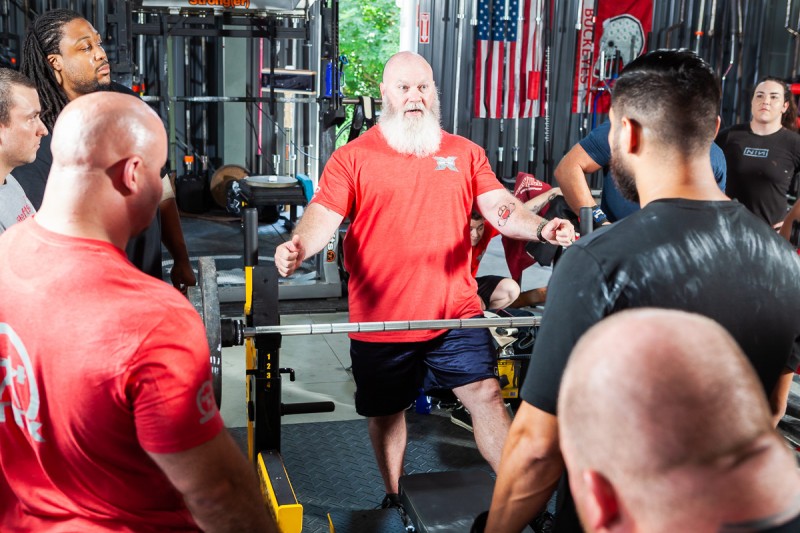
Leadership, besides COVID protocols, is the biggest challenge that we ALL face as strength coaches. It does not matter if you are in the National Football League, college, or your garage gym: there is always some type of void to fill. A void for someone to step up and take charge. Leadership comes in many forms, and when you have it, especially in a team setting, you become very hard to beat. If you don’t have it, mediocracy at best.
I have said this to my athletes for years, and it is not just talk—it is an undeniable fact: teams that are player-led (in the right direction) will win a lot more games than they lose. Every single winning season that I have been a part of has had unbelievably strong leadership from its players. They all had that special chemistry that makes them a band of brothers. Strong leadership is not just for athletes, either: it goes for staff members, coaches, interns, and administrators. The two big questions we have to answer before we dive into this side of the pool are, what is leadership, and how do we go about cultivating it?
RECENT: Guns Up, Let's Do This!
There are a million definitions of leadership, but here is what the “formal” definition is:
Leadership: the action of leading a group of people or an organization.
The definition of leading is:
Show someone or something the way to a destination by going in front or beside the person or thing. Be a route or means of access to a particular place or in a particular direction.
Notice how it says by going in front or beside the person or thing. This is where the true definition lies, and I would also add behind the person or thing.
As coaches, we have to find out what makes our athletes tick and then continue to throw logs on that fire. Some guys need a little, and some need a lot. This is why I am so glad I was involved in coaching powerlifters early in my career. I realized that everyone needed something different to get going. Some would just get their knees wrapped, follow a few cues, and go out and crush world records. Other guys would need complete anarchy, yelling, throwing things—anything to get them going. They would charge the platform like a rhinoceros looking for love in all of the wrong places. I tried to keep those lessons in mind as my career shifted to team sports. Sometimes it worked, and sometimes it didn’t. Here are four takeaways that I have seen over the past 25 years in this business regarding leadership.

You must have clear, concise goals for where your team is going and how you will get there.
If you do not have this, you do not have a chance at winning whether you are cultivating leadership in yourself, your team, or your staff. As they say, you cannot be a ship without a rudder. You must have goals, rules, and regulations regarding what you are going to tolerate and what you are not. If they do not come from above, then you must provide them to your staff, and they must implement them for the players. This is your goal (the plan), and your process is how you are going to get there. Jewelry or no jewelry? Squat to depth or not? Punishments for missing, music or no music—you must decide all of this and get everyone on the same page. Teach it to your staff, and make sure that you tell it to the players clearly and concisely.
There is no faster way to lose a kid than yelling or punishing him for doing something wrong that he did not know was wrong. Players must know the expectations of what you want from them and what they will get from you. I tell athletes on recruiting visits that if they don’t like to work, then this is not the place for you—don’t come here. That is an expectation from the start: if you are here, you’re going to work.
You MUST cultivate the best players and do all you can to teach them how to lead through your process.
This is the group that leads from the front. Your best players on the field have to be those leaders. When I am talking about these leaders, I am not talking about guys who are yelling and screaming but are respected by all and if they speak up or tell a teammate to do something, they will do it. With this group, you should just have to point them in the direction that you want the team to go and then let them rip. This is where your leadership comes into play. Again, you all have to be on the same page in terms of the team direction or this will never work.
Another important fact is that if you have only one good player with a strong personality, then that’s just one. Coach, player—it just does not matter. If you are not a good player or do not have a strong personality as a coach, you cannot lead from the front. Many are called, and few are chosen. I know there are exceptions to every rule, but as a mainstay, this is how things work. I have worked with winning coaches who were very selective on who could talk to their teams, even guest speakers. All were carefully vetted to make sure that they were in line with the team message and the team goals. Others would let just about anyone speak to the team. Guess which coaches were more successful?
Once you have identified the leadership in front, you can move on to those who can lead beside the team.
This is where as a strength coach, you will be the busiest, and this is where our profession turns from science to an art. There will be guys who may not be great players on the field or have strong personalities but work their butts off day in and day out. These are the coaches or athletes who are your boots on the ground. They take care of their specific groups or racks just by how hard they work, and they understand what those small groups need. With your staff, this may be the most important factor.
When choosing a staff, I was sure to include coaches with very different personalities. I was at one end of the spectrum. I have a very strong personality, so I would work with the players who had strong personalities. I had others on my staff who did not have strong personalities, and guess who they worked with? The guys who didn’t have strong personalities. Then, we had guys in-between. So, every type of player personality was covered, and everyone could be himself or herself. If we had personality conflicts, we had no problem with switching an athlete to another strength coach who was a better fit.
Once those groups were comfortable with each other, trust grew, followed by confidence. When every group was strong, the whole team was elevated, and everyone led, in his own way, to get us to our goal. It did not matter if the players were offense, defense, skill, or linemen. We worked personalities, not positions, to take all of the bullsh*t away. We got guys comfortable with being themselves and let them thrive.
I had only three rules with my staff: no egos, do whatever it takes to be ready for workouts, and lead your group through the process. Everything else just fell into place. In the places where those three rules were not followed, there was not a lot of winning.
The ones who can lead from the back.
The back? How can you lead from the back? I’ll tell you—because sometimes you have to pull and sometimes you have to push. This is what makes a pack of wolves so strong. The leader hunts from the back to make sure that all of the other wolves keep up in front of him, and he covers the rear in case of an attack from other predators.
One team that we had a few years ago had great leadership all around. One of our best players was a fullback that I would bet caused more concussions than any other player in our league. He was one of those guys that even if he hit you with an elbow on his way out to block, you would feel it. Tough as nails and would keep going like the terminator, arm hanging off and still bringing it. He was always in great shape but not very fast. He had a strong personality and led from the front and side, but during running sessions, he would get so mad because he could not run in front of his group and really wanted to be a great leader. One day, he voiced his frustrations during a session, and I told him that sometimes great leaders have to lead from the back. I pointed to two of our linemen who were really struggling with running, and I told him to go run with them. The front and side of this team are covered, plenty of leadership. We need someone to lead from the back so that no one gets left behind. A light bulb went off, and he ran with those guys for three weeks until they moved to the middle of the pack. We had a pretty damn good year that year, to say the least.
I hope that this article helped you to understand that leadership has many forms, and it is our job to sow the seeds of leadership throughout the whole team, not just in front, so that we can all share the fruits of our labor.











Thanks for everything you do for our industry Coach, cheers and hope the new year is a best ever for you and those you lead, Ashley